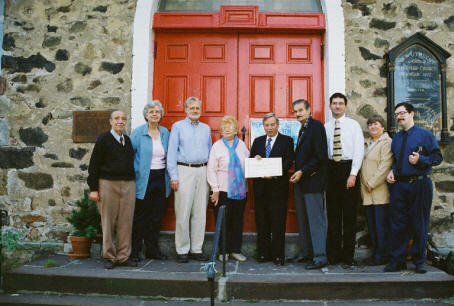|
New Utrecht Reformed Church
328 Years
1677-2005
Search
this site with Google.
Home
About Us
Archive
Bulletin
Children's Church
Consistory
Events at New Utrecht
Get to New Utrecht
History
Liberty Weekend
Links
News
News Releases
NURC in the News
Search
Site Map
What's New
E-mail
| |
Friends of Historic New Utrecht
Eds: For the attached photo, in the picture, left to right are:

Photo by Friends of Historic New Utrecht
Friends of New Utrecht members Dario Marotta, Maureen Ann Clements,
David Elligers, Rose Lood, Robert Buonvino, Erik Ander, Mary Shields and Vincent
La Marca with Assemblyman Peter J. Abbate Jr., center, as he presented a $250,000
check to be used toward repair and restoration of the New Utrecht Reformed
Church, a Brooklyn landmark dating back to 1828.
Immediate release
Brooklyn - On the very ground where George Washington once stood, New York
State Assemblyman Peter J. Abbate Jr. has taken a major step toward making
certain that a major piece of Brooklyn's history is preserved.
Abbate announced that $250,000 from the Assembly's capital funding will be used
toward restoration of the landmark New Utrecht Reformed Church at 18th Ave. and
84th St. in Bensonhurst, a stone and wood structure that until late in 2003 had
been an educational resource for thousands of New York City school children to
learn about the early history of Brooklyn and the nation.
"More than ever it is necessary for our young people and others to have a good
understanding of what this country is all about," Abbate, a Democrat, said as he
presented a large replica of the actual check to Robert Buonvino, president of
Friends of Historic New Utrecht, and Rose Lood, president of the New Utrecht
Liberty Pole Association and a longtime church leader.
"Hopefully, these funds will encourage further government and private donations
and be a sign of our commitment toward repair and restoration of this major
piece of Brooklyn's history," the assemblyman said. He called the building,
dating from 1828, an "American treasure" that cannot be replaced. Engineers and
architects put the cost of repairs at $1.8 million.
Abbate toured the building, where scaffolding now supports the roof. It was
erected soon after the doors to the former Dutch Reformed Church sanctuary were
closed to the public just before Christmas out of concern that the roof might
fall in under the weight of last winter's snow.
Since then, historian Buonvino has said, the building has sat "quietly and dark,
awaiting our help." Now," he adds, "thanks to the assemblyman and others, we are
starting to financially see the light of day." Besides government funding, he
said, "we have a need for more private citizens, banks, foundations and
companies to all work together for the benefit of our children and community."
Until late 2003, the building, with its historic architecture, stained-glass
windows and pipe organ, had housed numerous public school programs, many
centering on the early history of the nation. "In this 'cultural-educational
shrine'," Buonvino has said, "we have brought together thousands of school
children, placing them in a setting that 'cries out' with the kind of knowledge
it is essential for them to experience."
On the site where the presentation ceremony took place Oct. 8, George Washington
visited students at an academy, a portion of which has been uncovered by college
students in an archeological dig on the church grounds. It also has become the
place where the annual Brooklyn Columbus Day Parade has its closing ceremony, as
it did on Saturday.
When Washington visited, the New Utrecht Reformed Church, which first opened its
doors in 1677, had its building near 16th Ave., where it still maintains its Old
Dutch Cemetery, the oldest operating cemetery in the region including Brooklyn,
Queens and Nassau and Suffolk counties. The 1654 burial ground is used by the
Friends organization for educational tours for students and other groups
throughout the year.
The church grounds are easily identifiable by the Liberty Pole on its front
lawn, 106 feet high with a "Liberty Eagle" on top. The first pole was placed
there in 1783 to celebrate that the British were leaving the shores of what was
to become the United States of America.
Persons interested in learning more about Brooklyn's early history are invited
to call 1-718-256-7173 or 1-718-234-9268. They also may log onto the Friends of
Historic New Utrecht's Web site at
www.historicnewutrecht.org. Contributions for repair and restoration of the
landmark are welcome at Friends of Historic New Utrecht, 1831 84th St.,
Brooklyn, NY 11214. Checks, tax deductible, may be made out to the Friends of
Historic New Utrecht Restoration Fund.
###
Public relations services donated by bhprEspeciallyForChurches October 12, 2004
|